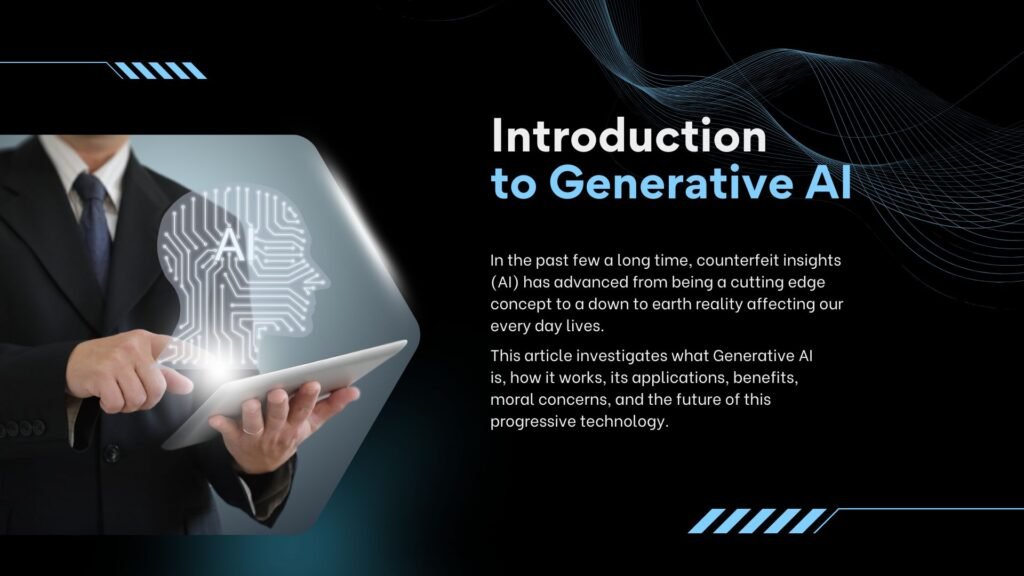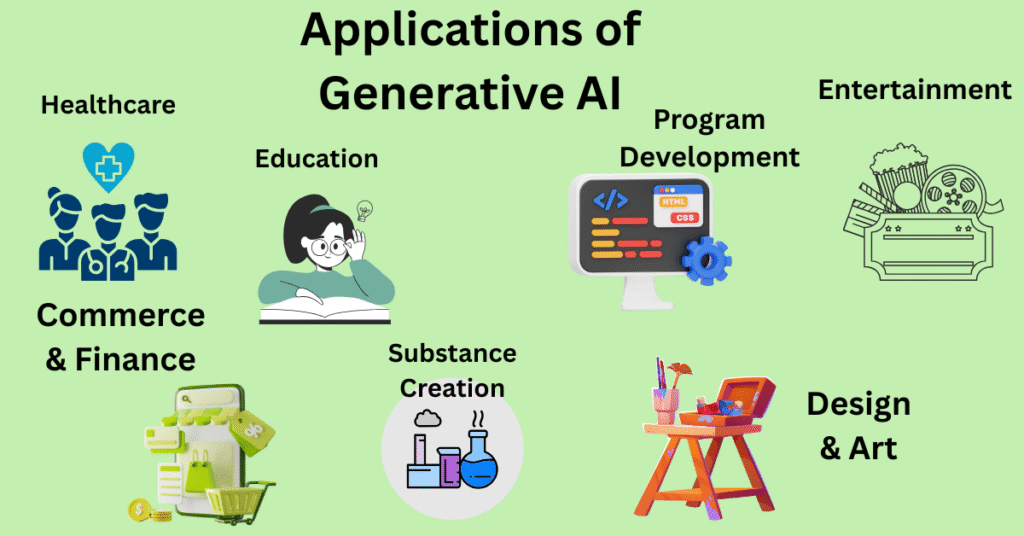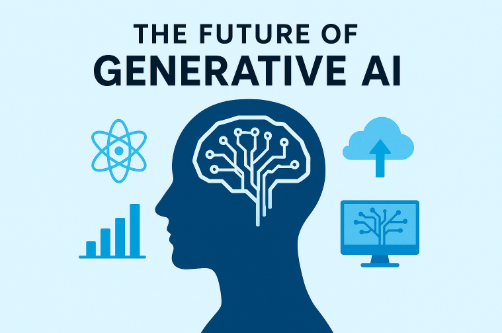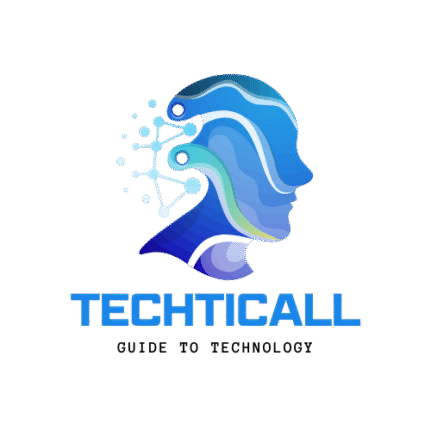Introduction:
In the past few a long time, counterfeit insights (AI) have advanced from being a cutting-edge concept to a down-to-earth reality affecting our everyday lives. Among the most groundbreaking developments in AI is (GenAI)—a capable department of fake insights able of making modern substance, thoughts, and arrangements. Not at all like conventional AI models that as it were analyze and classify information, Generative AI goes a step advance by creating unique yields such as content, pictures, music, recordings, 3D models, and indeed computer program code.
From AI-powered chatbots like ChatGPT to picture era instruments like DALL·E, GenAI has quickly ended up a central constrain in businesses counting healthcare, fund, amusement, instruction, showcasing, and program advancement.
This article investigates what Generative AI is, how it works, its applications, benefits, moral concerns, and the future of this progressive technology.

What is Generative AI?
It alludes to a lesson of counterfeit insights models planned to create unused and unique information that takes after human-created substance. These models learn from huge datasets and at that point utilize progressed calculations to create yields such as:
- Text (articles, stories, lyrics, code)
- Images (craftsmanship, practical photographs, designs)
- Music and sound (tunes, sound impacts, voice synthesis)
- Videos (movements, film trailers, deepfakes)
- Scientific disclosures (sedate particles, building designs)
It does not fair rehash existing data. Instep, it gets it designs, structures, and connections inside information and employments this information to produce yields that show up unused and creative.
The Advancement of Generative AI
The history of Generative AI can be partitioned into key milestones:
I. Early AI (1950s–1980s)
- AI inquire about centered on rule-based systems.
- Machines seem take after enlightening but not make modern ideas.
2. Neural Systems (1980s–1990s)
- Inspired by the human brain, neural systems progressed machine learning.
- Still, imagination was restricted due to little datasets and moo computing power.
3. Deep Learning (2000s)
- With the accessibility of huge information and progressed GPUs, profound learning models developed stronger.
- AI started accomplishing breakthroughs in picture acknowledgment, discourse acknowledgment, and characteristic dialect processing.
4. Generative Antagonistic Systems (GANs) (2014)
- Proposed by Ian Goodfellow, GANs permitted AI to create reasonable pictures and media.
- This was the to begin with genuine step toward machines making modern, human-like content.
5. Large Dialect Models (2018–Present)
- OpenAI’s GPT (Generative Pre-trained Transformer) course of action and Google’s BERT revolutionized characteristic tongue generation.
- AI seem presently compose papers, make craftsmanship, and banter like humans.
How Does Generative AI Work?
It depends on machine learning models prepared on endless sums of information. The two most prevalent approaches are:
I. Generative Antagonistic Systems (GANs)
- GANs comprise of two neural systems: a generator and a discriminator.
- Through this competition, the generator moves forward until it produces profoundly practical outputs.
2. Transformer Models (LLMs like GPT, BERT, etc.)
- Transformers utilize profound neural systems with consideration mechanisms.
- They analyze the connections between words, pictures, or sequences.
Applications of Generative AI
It is changing numerous businesses with real-world applications.
I. Substance Creation
- Writers & Bloggers: Produce web journal posts, stories, and articles.
- Marketing: Make advertisement duplicate, mottos, and social media posts.
- Journalism: Draft news rundowns and press releases.
2. Design & Art
- AI apparatuses like Midjourney and DALL·E make works of art, logos, and 3D designs.
- Fashion creators utilize GenAI to plan clothing prototypes.
3. Healthcare
- AI models produce potential sedate molecules.
- Helps in protein structure forecast and personalized medicine.
- Generates manufactured restorative information for preparing without security risks.
4. Education
- AI mentors produce personalized learning materials.
- Assists understudies with clarifications, hone questions, and summaries.
5. Program Development
- Tools like GitHub Copilot create code, propose bug fixes, and speed up development.
6. Entertainment
- AI creates music tracks, video scripts, and animations.
- Deepfake innovation is utilized in motion pictures and gaming.
7. Commerce & Finance
- Automates report era and monetary analysis.
- Creates prescient models for stock exchanging and chance assessment.

Benefits of Generative AI
- Increased Efficiency – Robotizes monotonous tasks.
- Creativity Boost – Makes a difference people brainstorm and innovate.
- Cost Proficiency – Diminishes time and assets for substance creation.
- Accessibility – Makes data and creativity available to everybody.
- Personalization – Conveys custom arrangements for instruction, promoting, and healthcare.
Challenges and Concerns
While Generative AI is progressive, it comes with challenges:
I. Ethical Concerns
- Fake news, deepfakes, and misinformation.
- Intellectual property theft.
2. Bias and Fairness
- AI can acquire inclinations from preparing data.
- Risk of segregation in enlisting, law, and finance.
3. Job Displacement
- Some inventive and schedule occupations may be automated.
4. Security Risks
- AI-generated malware or phishing content.
5. Regulation and Governance
- Lack of worldwide laws for moral AI use.
The Future of Generative AI
- Hyper-Personalization in promoting, healthcare, and education.
- AI-Human Collaboration for imaginative projects.
- Smarter AI Collaborators with thinking and problem-solving skills.
- Improved Controls guaranteeing secure and moral use.
- Scientific Breakthroughs in sedate disclosure, climate modeling, and engineering.

Conclusion:
Generative AI is more than fair a innovative advancement—it is a worldview move in imagination and development. From making practical pictures to helping in logical investigate, it has the control to change businesses and rethink human potential. Whereas challenges exist, with mindful utilize, Generative AI can open entryways to unused conceivable outcomes, forming a future where people and machines collaborate for progress.
As we move forward, the key lies in adjusting development with morals, guaranteeing that Generative AI benefits society whereas minimizing dangers. The coming decade will likely witness Generative AI not as it were as a device but as a accomplice in human imagination and problem-solving.
FAQs
1. What is Generative AI in basic terms?
Generative AI is a sort of counterfeit insights that can make modern substance like content, pictures, music, and recordings by learning from existing data.
2. How is Generative AI diverse from conventional AI?
Traditional AI analyzes and classifies information, whereas Generative AI produces unused and unique yields that mirror human creativity.
3. What are a few prevalent cases of Generative AI?
- ChatGPT (content generation)
- DALL·E and MidJourney (picture generation)
- GitHub Copilot (code generation)
- Stable Dissemination (craftsmanship and design)
4. Is Generative AI dangerous?
Generative AI is capable but can be abused for spreading deception, deepfakes, or one-sided yields. Capable utilize and controls are essential.
5. Will Generative AI supplant human jobs?
It may mechanize a few assignments, but it is more likely to help people, upgrade imagination, and make modern work opportunities.
6. How does Generative AI affect businesses?
It boosts efficiency, decreases costs, makes a difference in information examination, and makes strides client engagement through personalization.
7. What aptitudes are required to work with Generative AI?
- Machine learning and profound learning basics
- Data science and programming (Python, TensorFlow, Py Torch)
- Prompt building for AI tools
- Ethical AI knowledge
